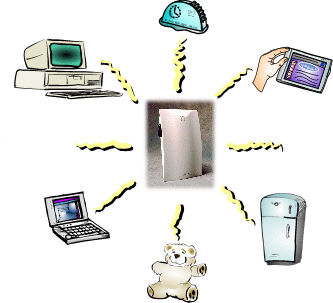|
Careful to avoid tripping over wires, the system operator makes his way to the console. The roar of cooling fans fills the room as he presses the power switch. The great machine lumbers to life. Arcane diagnostic messages flash on the console as each subunit reports its status. Instantly, the great machine has executed over a million steps, but even with its tremendous speed, it is so important and busy that it takes over a minute to get up for work. Finally, the parade of peripherals stops. The machine starts loading and processing its tremendous operating system which has taken over 16 years to produce, and if it were in book form, would occupy 45,000 single-spaced pages and be six feet thick.
Despite years of training at a top engineering school, the system operator cannot fix the problem. Hours of reboots, calls to customer support, even a total reinstallation of the operating system is all to no avail. The system operator, exasperated, retreats to the kitchen for a restorative glass of orange juice. Browsing the web will have to wait. Scenarios like this are playing out every day. In the home, the classroom, and the office. Drawn by the promise of a solution to our problems, we find ourselves involved in the hands-on system operation of a great machine. The PC revolution, which was said to shatter the glass walls of the information processing centers and bring computing to the average man, has instead erected those same walls around us. Now we need to be a highly competent systems operator, fluent in the language of RAM, CPU, disk, megahertz, and TCP/IP. This isn't to say that the great machine is unnecessary or useless. For processing large amounts of information, such as company balance sheets or three-dimensional airplane designs, the PC is a requirement. However, the average person is running out of big tasks. In fact, our lives are turning towards accessing networked information. Rarely do we run a fluid dynamics experiment; more often, we want to check the television schedule, find out if a package is on time, or talk with our family. These tasks involve data that is not on our computer — which means the power inherent in the great machine is incongruous, unnecessary, and excessive. So what could be better than the great machine? The next evolutionary step: the adequate machine.
Imagine that it's 6:00 AM on a cold Monday morning. Your alarm clock is beeping, but you don't want to get up yet. You hit the 'snooze' button, and then the 'traffic' button. A voice tells you that traffic between your house and work is light this morning, with no delays expected. Satisfied that you can sleep for another ten minutes, you drift away. Nothing prevents the traffic button from existing today. Traffic information is freely available on the Internet; speaking alarm clocks are commonplace; and network connection technology is free. The only problem delaying a new wave of information-enabled appliances is the confused state of the infrastructure. The current infrastructure presumes that the great machine is the terminus. One data stream leads to the PC and stops there, at the modem. If you want networked information, you must go to the great machine. Hence, in order to access the World Wide Web, you must maintain a nest of wiring, a computer, an operating system, and a large suite of programs and peripherals. It doesn't have to be this way. You could receive your Internet data stream invisibly, like you receive your phone or cable data streams. Instead of acting as a system operator for a powerful data processing machine, you could interact with networked information in a casual, natural manner. The solution is the Net Utility Box. These attach to your wall, or to the side of your house. They are managed and maintained by your Internet service provider. You are no longer responsible for the care and upkeep of your network connection; it has receded into the world of anonymous, adequate appliances.
We don't have to live with the limitations of the great machine any longer. Adequate machines can free us from our system operator roles and put computing in its proper place as an enhancement to our lives. Net Utility Boxes are the starting gate for a new world.
|
||||||||||||||||||||

 But today the system operator is not lucky. Two subunits, each convinced that they have a right to a particular chunk of the machine's resources, are battling it out for control. The operating system attempts to intervene, but it can't find a solution; instead, it desperately chronicles the conflict on the video screen.
But today the system operator is not lucky. Two subunits, each convinced that they have a right to a particular chunk of the machine's resources, are battling it out for control. The operating system attempts to intervene, but it can't find a solution; instead, it desperately chronicles the conflict on the video screen. These devices also make your house into a small Internet. The Net Utility Box creates a wireless network so you can decouple form from function. You can browse the web on a small, dedicated portable device rather than at the desk; or you can access your alarm system from work. You can use many information-enabled appliances, seamlessly and simultaneously, without having to worry about the implementation details.
These devices also make your house into a small Internet. The Net Utility Box creates a wireless network so you can decouple form from function. You can browse the web on a small, dedicated portable device rather than at the desk; or you can access your alarm system from work. You can use many information-enabled appliances, seamlessly and simultaneously, without having to worry about the implementation details.